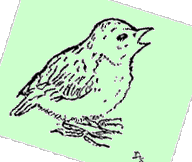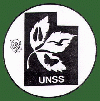|







|
. |
 "Speck"
came to us as a small, speckled, brown nestling brought by a young
neighbor who found him "over at the hollow" and didn't quite know what
to do with him. He was adopted and named "Speck". A large cardboard box
with a nest of facial tissues, the floor lined with newspapers, and a cover
of nylon net became his quarters. Speck used the tissue nest for only three
nights, as it was found that sand was much better for him than newspapers.
Hardboiled egg yolk, mashed, and mixed with pablum and milk or water were
his first meals, taken with a light, sweet peep. This was fed on the tip
of a tapered popsicle stick.
"Speck"
came to us as a small, speckled, brown nestling brought by a young
neighbor who found him "over at the hollow" and didn't quite know what
to do with him. He was adopted and named "Speck". A large cardboard box
with a nest of facial tissues, the floor lined with newspapers, and a cover
of nylon net became his quarters. Speck used the tissue nest for only three
nights, as it was found that sand was much better for him than newspapers.
Hardboiled egg yolk, mashed, and mixed with pablum and milk or water were
his first meals, taken with a light, sweet peep. This was fed on the tip
of a tapered popsicle stick.

 His true identity was a puzzle. His speckled back and white outer tail
feathers resembled those of a meadowlark, but he was far too small. Besides,
the meadowlark's habitat was on the flat grassy land above the "hollow"
where Speck was found. Nor was his beak like that of a meadowlark. Speck
walked instead of hopping, and he could not perch. What bird in the "hollow"
did not perch? He couldn't be a sandpiper. Three toes pointing forward and
one backward, with a very elongated and elegant claw or spur, could only be
the foot of a true lark, represented by only one species, the Horned Lark.
His true identity was a puzzle. His speckled back and white outer tail
feathers resembled those of a meadowlark, but he was far too small. Besides,
the meadowlark's habitat was on the flat grassy land above the "hollow"
where Speck was found. Nor was his beak like that of a meadowlark. Speck
walked instead of hopping, and he could not perch. What bird in the "hollow"
did not perch? He couldn't be a sandpiper. Three toes pointing forward and
one backward, with a very elongated and elegant claw or spur, could only be
the foot of a true lark, represented by only one species, the Horned Lark.

 As the days passed, Speck's head began to show the Horned Lark's "horns".
At night he would settle down in the sand and wiggle back and forth until
he was only a small brown mound. He was not too noisy, but when hungry he
would give a few small plaintive and very sweet "pee-ups". After eating,
he appeared to clean his beak, swiping it back and forth scythe-like in
the sand. When I had to go to a nearby scout camp for a couple of days,
Speck went along and was fed his "baby" food every hour. He thrived, and
soon became a fledgling anxious to try his wings. He must learn to take
care of himself before returning to the wild. This presented a perplexing
problem. If he had his flying lessons outside, a cat might readily get him;
so Speck had to learn to fly inside the house. The first time, he was
released in a rather small room. I thought he would only fly a few feet,
but he had not been trying his wings for nothing. He soared across the room
and crashed into the far wall. Though shaken up a bit, he appeared to be
unharmed. Thereafter, he was taken to a larger area. Soon he could bank,
turn, and fly from one room to another, landing lightly on the floor or
other flat area. He never did learn to perch, and I learned something new
about Horned Larks.
As the days passed, Speck's head began to show the Horned Lark's "horns".
At night he would settle down in the sand and wiggle back and forth until
he was only a small brown mound. He was not too noisy, but when hungry he
would give a few small plaintive and very sweet "pee-ups". After eating,
he appeared to clean his beak, swiping it back and forth scythe-like in
the sand. When I had to go to a nearby scout camp for a couple of days,
Speck went along and was fed his "baby" food every hour. He thrived, and
soon became a fledgling anxious to try his wings. He must learn to take
care of himself before returning to the wild. This presented a perplexing
problem. If he had his flying lessons outside, a cat might readily get him;
so Speck had to learn to fly inside the house. The first time, he was
released in a rather small room. I thought he would only fly a few feet,
but he had not been trying his wings for nothing. He soared across the room
and crashed into the far wall. Though shaken up a bit, he appeared to be
unharmed. Thereafter, he was taken to a larger area. Soon he could bank,
turn, and fly from one room to another, landing lightly on the floor or
other flat area. He never did learn to perch, and I learned something new
about Horned Larks.

 My son was concerned whether Speck would be able to feed himself when in the
wild, and wondered how I was going to teach a bird to catch insects.
I suggested he catch a few and put them in Speck's box to see what would
happen. Some small grasshoppers were offered to Speck, and the predator
instinct took over as he made a meal of the insects. He also was fed some
parakeet seed mix, but the pablum was given only when necessary.
My son was concerned whether Speck would be able to feed himself when in the
wild, and wondered how I was going to teach a bird to catch insects.
I suggested he catch a few and put them in Speck's box to see what would
happen. Some small grasshoppers were offered to Speck, and the predator
instinct took over as he made a meal of the insects. He also was fed some
parakeet seed mix, but the pablum was given only when necessary.




 Ten days after getting Speck, he was ready to return to his native habitat.
I hoped his familiarity with humans would not have caused him harm. Shawn,
our ten year old who had helped care for him, accompanied me on this trip.
Speck was taken to his grassy homeland, where other larks, perhaps his
parents, were seen. When released, he soared about forty feet and landed.
I walked toward him taking pictures. He found an insect or two, his first
real act of independence. Instantly he devoured them. He flew again and
let us come to him, but did not want to return to the box. He was
free! I checked on Speck for several days. He would allow me to get no
closer than a few feet, cocking his head to watch me. Having Speck was a
pleasure, for he taught us much. May he have a long and happy life!
-- by Dorothy K. Platt
Ten days after getting Speck, he was ready to return to his native habitat.
I hoped his familiarity with humans would not have caused him harm. Shawn,
our ten year old who had helped care for him, accompanied me on this trip.
Speck was taken to his grassy homeland, where other larks, perhaps his
parents, were seen. When released, he soared about forty feet and landed.
I walked toward him taking pictures. He found an insect or two, his first
real act of independence. Instantly he devoured them. He flew again and
let us come to him, but did not want to return to the box. He was
free! I checked on Speck for several days. He would allow me to get no
closer than a few feet, cocking his head to watch me. Having Speck was a
pleasure, for he taught us much. May he have a long and happy life!
-- by Dorothy K. Platt
|
|



